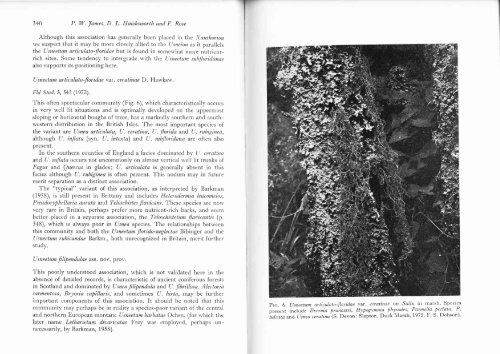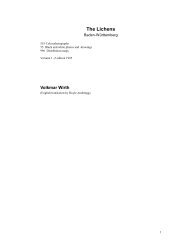Lichen communities in the British Isles: A preliminary conspectus
Lichen communities in the British Isles: A preliminary conspectus
Lichen communities in the British Isles: A preliminary conspectus
You also want an ePaper? Increase the reach of your titles
YUMPU automatically turns print PDFs into web optimized ePapers that Google loves.
340 P. W. James, D. L. Hawhsworth and F. Rose<br />
Although this association has generally been placed <strong>in</strong> <strong>the</strong> Xattthorion<br />
we suspect that it may be more closely allied to <strong>the</strong> (Jsneion as it parallels<br />
<strong>the</strong> (Jsneetum articulato-foridae b:ut is found <strong>in</strong> somewhat more nutrientrich<br />
sites. Some tendency to <strong>in</strong>tergrade with <strong>the</strong> Llsneetum sultfloridanae<br />
also supports its position<strong>in</strong>g here.<br />
U sne etum artic ulato-floridae v ar. c er at<strong>in</strong>ae D. Hawksr.r'.<br />
Fld stud.3,5+3 (1972).<br />
This often spectacular community (Fig. 6), which characteristically occurs<br />
<strong>in</strong> very well lit situations and is optimally developed on <strong>the</strong> uppermost<br />
slop<strong>in</strong>g or horizontal boughs of trees, has a markedly sou<strong>the</strong>rn and southwestern<br />
distribution <strong>in</strong> <strong>the</strong> <strong>British</strong> <strong>Isles</strong>. The most important species of<br />
<strong>the</strong> variant are Usnea articulata, U. cerat<strong>in</strong>a, U. florida and U. rubig<strong>in</strong>ea,<br />
although U. <strong>in</strong>flata (syn. U. <strong>in</strong>texta) and U. subfloridana are often also<br />
present.<br />
In <strong>the</strong> sou<strong>the</strong>rn counties of England a facies dom<strong>in</strong>ated by U. cet,at<strong>in</strong>u<br />
and U. <strong>in</strong>flata occurs not uncommonly on almost vertical lvell lit trunks of<br />
Fagus and Quercus <strong>in</strong> glades; U. articulata is generally absent <strong>in</strong> this<br />
facies although U. rubig<strong>in</strong>ea is often present. This nodum may <strong>in</strong> future<br />
merit separation as a dist<strong>in</strong>ct association.<br />
The "typical" variant of this association, as <strong>in</strong>terpreted by Barkman<br />
(1958), is still present <strong>in</strong> Brittany and <strong>in</strong>cludes Heterodermia leucomelos,<br />
Pseudocyphellaria aurata and Teloschistes flaaicans. These species are now<br />
very rare <strong>in</strong> Brita<strong>in</strong>, perhaps prefer more nutrient-rich barks, and seem<br />
better placed <strong>in</strong> a separate association, <strong>the</strong> Teloschistetum flavicantis (p.<br />
348), which is always poor <strong>in</strong> (Jsnea species. The relationships between<br />
this community and both <strong>the</strong> Usneetum forido-neglectae Bib<strong>in</strong>ger and <strong>the</strong><br />
Llsneetum rubicundae Barkm., both unrecognized <strong>in</strong> Brita<strong>in</strong>, merit fur<strong>the</strong>r<br />
study.<br />
Usneetum filipendulae ass. nov. prov.<br />
This poorly understood association, which is not validated here <strong>in</strong> <strong>the</strong><br />
absence of detailed records, is characteristic of ancient coniferous forests<br />
<strong>in</strong> Scotland and dom<strong>in</strong>ated by Usnea filipendula and U. fbrillosa. Alectoria.<br />
sarmentosa, Bryoria capillaris, and sometimes (J. hirta, may be fur<strong>the</strong>r<br />
important components of this association. It should be noted that this<br />
commr,rnity may perhaps be <strong>in</strong> reality a species-poor variant of <strong>the</strong> central<br />
and nor<strong>the</strong>rn European montane (Jsneetum barbatae Ochsn. (for which <strong>the</strong><br />
later name Letharietum dioaricatae Frey was employed, perhaps unnecessarily,<br />
by Barkman, 1958),<br />
Frc. 6. (Jsneetum articulato-floridae var. ceyat<strong>in</strong>ae on salix <strong>in</strong> marsh' species<br />
present <strong>in</strong>clude Eaernia prunastri, Hypogymnia pl'4tsodes, Parmelia perlata, P.<br />
sulcata afld (Jsnea cerat<strong>in</strong>a (s. Devon: slapton, Duck Marsh, 1975, F. S. Dobson).





